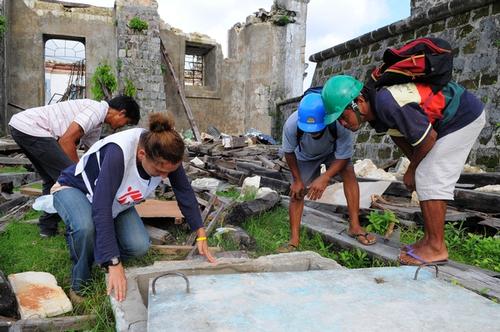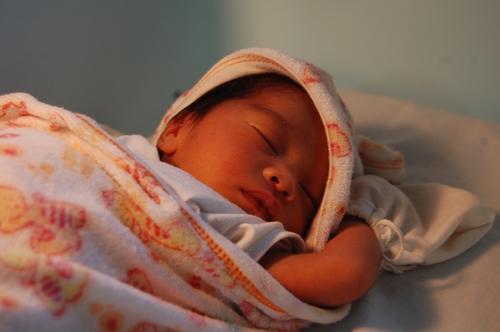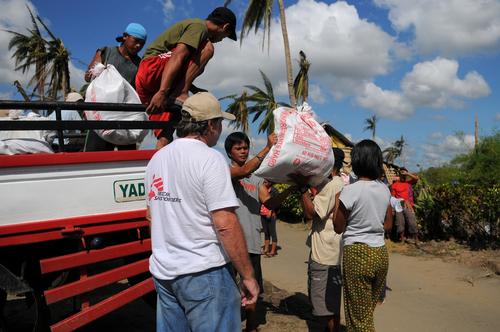As well as providing medical care and relief items, teams from Médecins Sans Frontières (MSF) are distributing clean drinking water to people in areas affected by typhoon Haiyan in the Philippines. Water and sanitation expert Azzurra D'Inca describes how they set about supplying water to 20,000 people in the city of Guiuan, on Samar island.
What did you see when you arrived in Guiuan?
We arrived a couple of days after the typhoon hit. The situation was appalling. The level of destruction was what you’d expect from an earthquake, not from a storm. It was difficult to assess the situation because everything was covered in rubble and debris. Initially we focused on providing water for the hospital to create an environment in which our medical staff could do their work.
The city’s water supply system had been reasonable before the typhoon, but the pipelines were all destroyed, so people were getting water from wells using hand pumps. The problem was that the wells were contaminated either with salt water from the storm surge, with dirty floodwater or with debris. So we installed water bladders in the city to hold reservoirs of clean water.
Why is providing water a priority in the wake of a natural disaster?
Clean water is essential to people's health. We know from previous experience that a lack of clean water can cause outbreaks of waterborne diseases. But it is not just about drinking water – it’s also about hygiene and sanitation. A lack of hygiene combined with a shortage of clean water makes people more susceptible to diseases. And when people get sick, they are more vulnerable. Five weeks after the typhoon, we have accomplished a lot in terms of water and sanitation, but it is still too early to say we are in the clear. We still need to be vigilant.
What are the biggest challenges in providing water in Guiuan?
The population in the Guiuan area is scattered, which makes this response a bigger challenge than, for example, providing water to a refugee camp, where everyone is in one place. Until the water supply system is working again, we need to provide people with alternative sources of water.
We’re assisting a total of 20,000 to 25,000 people, through lots of small projects. In one place we have built emergency community latrines; in another we are using trucks to distribute water and keep water bladders topped up. We’re also starting a campaign to prevent dengue fever, and we are in the middle of a well cleaning initiative. After the wind blew away their covers, many wells became contaminated. So we are cleaning the wells by pumping out the contaminated water, scrubbing their walls and disinfecting them with chlorine. So far, we have cleaned about 40 wells, most of them in Guiuan town, and we aim to clean at least 200.
What is MSF doing in terms of diarrhoea and dengue fever, an endemic disease here?
We are in constant communication with the medical team, and if there's a case of diarrhoea or dengue fever, we go to where the patient is living and investigate the source. If it’s a case of diarrhoea, we check the water source and the sanitary situation. With dengue fever, it's a bit more complicated, as dengue is caused by mosquitoes which bite during the day and which breed in clean water – even in drinking water.
Before the typhoon, there was a good national dengue prevention programme in place, meaning that people already have an understanding of preventive measures. However, the existing programme has been disrupted and most of the equipment was washed away. Our community prevention programme involves a health promotion campaign showing people how to avoid getting bitten, while at the same time we are using chemicals to kill mosquito larvae in water, as well as sometimes using chemical sprays to kill the adult mosquitoes. These chemicals have all been approved for use by the World Health Organization and they aren’t dangerous to people.
How long will people in Guiuan depend on the drinking water that MSF is providing?
Rehabilitating the old water supply system is progressing day by day, and already people are taking less water from our reservoirs. The quantity of water we are providing has decreased from around 150,000 litres per day to 80,000 litres per day. So we are already scaling down, but I think it will be some months before we can phase out our emergency water supply completely.






